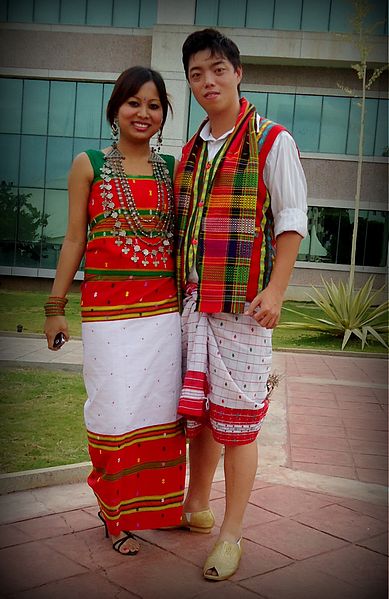
Traditional Attires in Tripura
Girl Wearing Risa (Source: tripura.org)Tripura is a traditional land which features a vast collection of inherited specialties of North East India, within which Tripura resides as a rich heritage of culture and artwork. Risa, Rignai and Rikutu being the traditional costumes of Tripura, features beautiful artistry of fabrics. It also exhibits a distinct contrast in style and feature from other regional costumes or dresses.
Origin and History
Weaving and the vast usage of handlooms had always been a matter of celebration and pride for the people of Tripura since its inception, and the women of Tripura had been investing themselves in initiating handmade crafts, textiles and garment designing to enhance them and also to bring about their own financial independence. Clothing in this region has always been an important part of the handicraft culture.
Style
Rignai is the lower half of the dress. It is like a draped skirt and has a significant cultural importance. Every clan in Tripura has their version of Rignai in terms of designs and patterns. A woman’s clan could be identified with the Rignai she was wearing. Although with time, due to the intermingling of people across clans the designs have seen a fusion of patterns.
Risa is a component of the female dressing culture in Tripura. It is the part of the dress which covers the upper half of women. The wearing of the Risa involves draping the chest around the back twice in order to provide protection and support to the chest. It is a culture in Tripura to where the Risa is worn by the bride during her wedding ceremony.
The main and most prominent characteristic of the woven Risa is their designing bears straight patterns of fabrics in both horizontal and vertical modes of view. This striped layout is supplemented with scattering and varying patterns of embroidery contrasted with thoughtful usage of colours. Earlier the thread used to design the Risa was woven at home from cotton balls. To meet the growing demands, the cotton threads are bought from the suppliers and the Risa weaving consequently takes lesser time. Nowadays, Risas are stitched and made along with the external upper garment.
Influences over the years
During the era of the famous king of Tripura- Subrai Raja, the women in his kingdom had developed innumerable designs for the Risa, but with the degradation of the empire and the progress of time, numerous designs were lost. The modern women of Tripura have taken up the responsibility to recreate the designs of Risa through their own skills and collective knowledge and further enhance the priceless heritage of cultural Tripura.
Innovations
In spite of various modern techniques that have been used to revamp and restyle the Risa, it still retains its prime feature of providing support and protection to the women. However, the Risa has also been modified to be used in tying a turban by the men, mainly during festivities and other social celebrations. It is innovatively structured to be draped as a scarf around the neck to protect from the cold. Newborn babies can also be carried in specially designed structures whose prime supporting component is a modified Risa.
Occasion dressing
Regarding daily and usual occasions, the Risa is chiefly used to provide safety to the body of women. As specialties, it is also coupled with a dhoti to provide firmness to the waist of the person. It also signifies the communal respectability of the individual. Moreover, in order to signify the guests of honor who are attending a gathering or social and communal festival or ritual, the Risa gets gifted to the guest as a token of gratitude and honor.
The Risa is a beautiful and a highly decorative garment which besides being a component of dressing, is also an object of gift which is much respected among the Tripuri individuals. It is resplendent and provides a proper suitability for many public ceremonies. The making of Risa requires a considerable amount of estimation and care as its applications and uses vary across individuals and occasions as well.
Global Influence
Being a large portion of the export articles of the culturally rich Tripura, and owing to its immense appreciation both locally and internationally, Risa contributes a lot to the profit procurement of Tripuri business. The international market exhibits a huge demand for Risa. Consequently, the Risa manufacturers and weavers are awarded recognition and appreciation on large public forums and practises as well.
Accessorizing
The varying designs of Tripuri clothing provide the scope for using it for different purposes and celebrations, with different dressing codes and presentations.
The use of embroidery and colors enhance the designs named Kwchak Pali Kosompali, Takhumtwi, Khamjang and several other variations of the Risa design in order to bring beauty and versatility to the overall apparel.
Chronicles of the future foretold
Rignai and Risa has undergone numerous improvisations throughout its evolution. However, in the future, with progress and improvisation, and also to save time in order, the Risa may be manufactured industrially to be inserted between the layers of clothing of the upper garment. This may however lead to reduction in the profits of the original weavers and handloom owners.
References
- http://www.indianetzone.com/9/costumes_tripura.htm
- http://en.wikipedia.org/wiki/Tripuri_dress
- http://en.wikipedia.org/wiki/Culture_of_Tripura
Categories: Attires, Clothing Styles & Drapes



